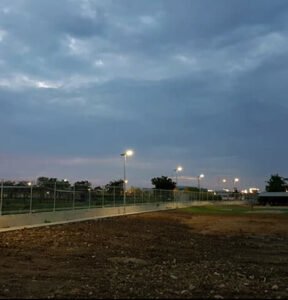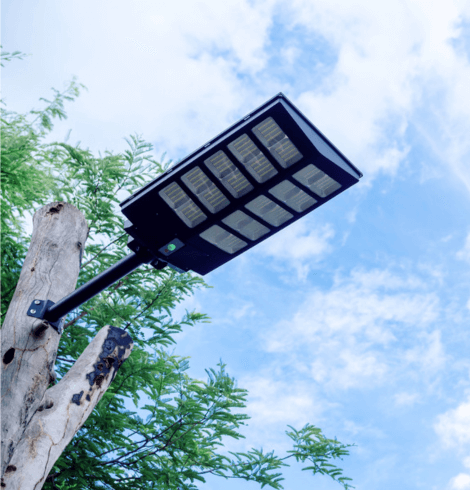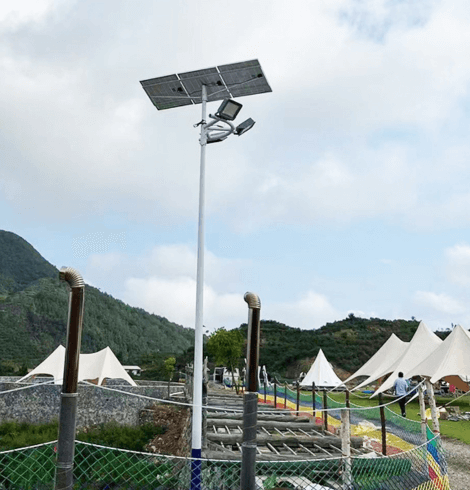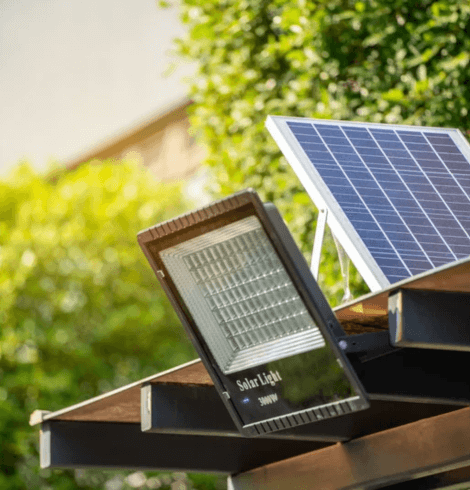Yes — solar street lights can be connected to the electricity grid, either as a hybrid system (solar + battery + grid) or as a grid-tied solution. This setup increases reliability, reduces power costs, and supports smart city infrastructure — making it ideal for large-scale urban and infrastructure projects.
Introduction
We usually picture solar street lights as self-contained systems: a panel on top, a battery inside, and a soft glow that turns on like clockwork at dusk. They don’t rely on power lines or electricity bills — just sunlight and smart design. And that picture isn’t wrong.
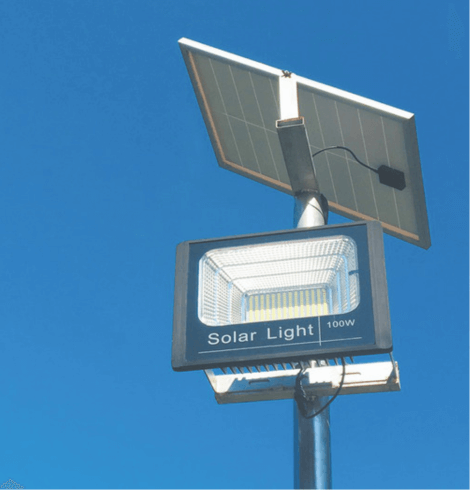
But there’s a lesser-known version of this story. In some cities around the world, solar street lights aren’t working alone. They’re teaming up with the electricity grid — and in doing so, they’re becoming more powerful, more reliable, and surprisingly more efficient. So how does that work? And more importantly, when does it make sense?
To answer that, let’s first understand the basics — where off-grid solar lighting excels, and what changes when you plug that system into the grid.
Table of Contents
ToggleUnderstanding the Basics: Off-Grid vs. Grid-Tied Lighting
What is a Standard (Off-Grid) Solar Street Light?
A standard solar street light doesn’t need help from the outside world. During the day, it collects energy from the sun. That energy charges a battery, and at night, the battery powers the light. It’s a neat little ecosystem. There are no wires to install, no monthly electric bills, and no dependence on a utility company.
This design works well in many situations — especially when lighting remote roads, parks, or neighborhoods where laying underground cables would be expensive or disruptive. But there’s a limit. When days are cloudy, or when a battery starts to wear out after a few years, these lights can start to struggle. You might not notice right away, but a series of cloudy days can quietly lead to nights without light.
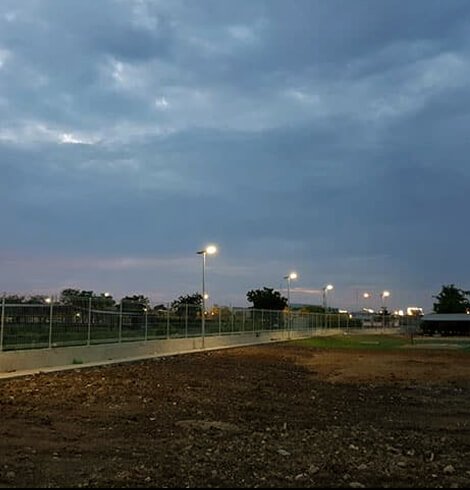
What Does It Mean to Connect to the Electricity Grid?
That’s where grid-tied lighting enters the conversation. Instead of being completely independent, these solar lights are connected to the local electricity grid. This gives them a safety net. They still use solar power when it’s available, but if the battery runs low or the weather turns bad, they can quietly draw electricity from the grid to keep shining. Some setups even skip the battery altogether and rely fully on this back-and-forth relationship — feeding solar energy into the grid during the day and pulling it back at night.
Once you understand these two models — off-grid and grid-tied — it becomes easier to appreciate the value of a third option that blends both.
Introducing the Hybrid Solar Street Light: The Best of Both Worlds
So what if you didn’t have to choose between being fully independent or fully dependent on the grid? That’s exactly what hybrid solar street lights offer.
They prioritize solar energy, store it in a battery, and lean on the grid only when absolutely necessary. You could think of them as independent most of the time, but flexible when needed.
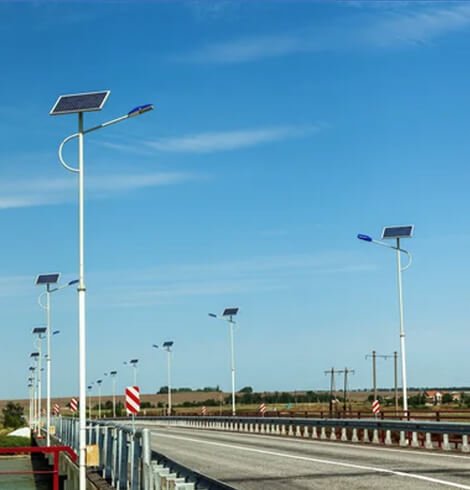
This flexibility is what makes hybrid systems so appealing. They’re designed to handle almost anything nature throws at them. During sunny days, they gather energy and charge up. At night, they use that stored power to illuminate streets. But if a battery dips too low — maybe after several days of overcast skies — the system doesn’t wait to fail. Instead, a smart controller quietly switches over to grid power, keeping the lights on without interruption.
These systems are built around coordination. A solar panel provides clean energy, a battery stores it, a smart controller manages everything in real time, and a connection to the grid ensures there’s always a fallback. In some cases, hybrid lights even feed excess solar energy into the grid during the day, reducing the city’s energy bill or even earning credits through net metering policies.
And this leads us to a bigger question: why go to all this trouble? What do we actually gain by adding the grid to something that’s supposed to be independent?
Top 5 Benefits of Connecting a Solar Street Light to the Grid
Once we look at how hybrid lights work, the advantages of grid integration become much clearer. It’s not about replacing solar power — it’s about making it more dependable, efficient, and cost-effective.
Reliable Lighting
First, grid integration improves reliability. If an off-grid system relies solely on battery storage and that storage runs out, the light goes dark. That’s a problem — especially in areas where public safety depends on well-lit streets. But hybrid lights solve this by switching to grid power when solar energy falls short. The transition happens automatically and instantly, so the street remains lit even during long storms or battery failure.
Cost Saving
Next comes cost savings. Hybrid lights still use solar energy as their main source. But when they generate more power than they need — particularly during sunny afternoons — they can send it into the grid. If local policies allow net metering, that surplus energy earns credits, which can be used to offset the small amount of electricity the lights pull from the grid at night. Over time, this exchange can lower utility costs significantly, especially for large lighting networks.
Longer Battery Life
Another benefit is battery life. Batteries don’t last forever, and their lifespan shortens when they’re constantly cycled from full to empty. In off-grid systems, that cycle happens every single day.
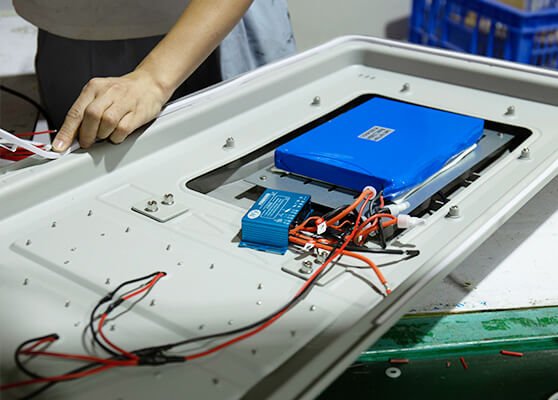
But hybrid systems lighten the load. If the battery gets too low, the system can pull a little power from the grid instead of pushing the battery to its limit. This gentler use means the battery stays healthier, longer — and replacements happen less often.
Support the Grid
There’s also a broader systems benefit. When solar street lights are connected to the grid, they become micro-generators during the daytime. Each one can help supply electricity to nearby homes or buildings, reducing demand on central power plants. It’s a small contribution individually, but across a city full of smart street lights, the impact can add up.
Smart City Ready
And finally, hybrid systems are a better fit for the cities of the future. Street lights are no longer just light sources. Increasingly, they’re hubs for Wi-Fi, traffic monitoring, security cameras, and other smart infrastructure. These features require steady power. With hybrid systems, cities can tap into solar power when it’s available and fall back on the grid when needed — ensuring those devices never lose connection.
These advantages raise another important question: if hybrid lighting offers so much, does off-grid lighting still have a place?
Hybrid vs. Fully Off-Grid: Which Is Right for Your Project?
Choosing between hybrid and off-grid solar lighting isn’t just about technology — it’s about context. The right system depends on location, climate, infrastructure, and long-term goals.
When to Choose Off-Grid
Off-grid lighting shines brightest — no pun intended — in areas where the grid simply doesn’t reach. That might be a rural village, a hiking trail, a beach promenade, or a new development where running wires would be costly. In these cases, off-grid systems provide lighting where there would otherwise be none. They’re easy to install, require no electrical permits, and deliver energy independence from day one.
When a Hybrid System is the Clear Winner
But in places where grid power is available, especially in urban and suburban settings, hybrid systems start to make more sense. They’re ideal when you want reliability without overbuilding battery capacity. They also become more appealing in regions with supportive energy policies — like net metering — where grid integration actually pays off financially. And if you’re installing a large number of lights, spreading out your energy risk across solar, battery, and grid sources makes operations more resilient.
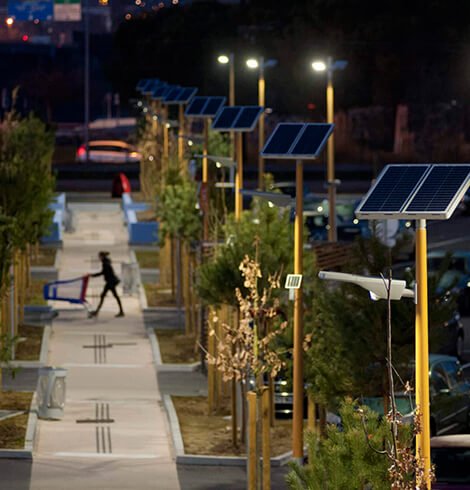
In short, hybrid systems are often the smarter long-term investment — but off-grid systems remain essential when connection simply isn’t an option.
Practical Considerations and Potential Challenges
As promising as hybrid systems are, integrating them into real-world infrastructure isn’t always plug-and-play. There are practical hurdles to consider, and addressing them early can save time, money, and frustration later on.
Installation Complexity and Initial Cost
Installation can be more involved than with off-grid lights. While a standalone unit can be bolted into the ground and left to work, a hybrid setup needs access to the grid. That means coordinating with utility companies, following local codes, and sometimes waiting for permits or inspections. Depending on how the city manages its lighting infrastructure, this process can be straightforward — or not.
Grid Access and Regulations
Then there’s the regulatory side. In some regions, policies around solar feed-in and metering are well developed. In others, they’re nonexistent or overly complex. A city planning to feed excess solar energy into the grid needs to make sure that’s even allowed — and understand how it will be compensated. Without net metering or feed-in tariffs, some of the economic benefits of grid-tied lighting could be lost.
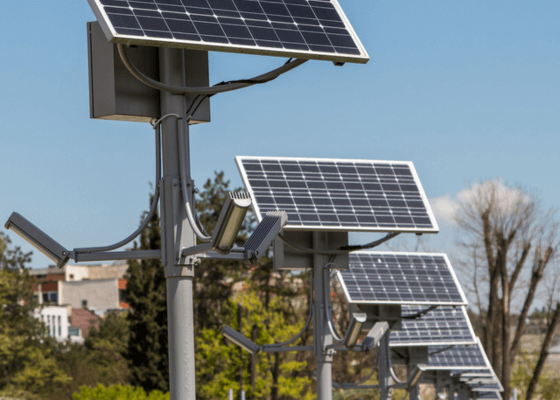
Maintenance Requirements
Finally, maintenance expectations may shift. Grid-tied systems may have more components to monitor — such as inverters or metering equipment — but they also tend to suffer fewer battery failures. In the end, it’s a different kind of upkeep, not necessarily a heavier one.
So yes, hybrid lighting brings more to the table — but it also asks a bit more from planners and engineers. Still, for many cities, that’s a trade worth making.
Quick Summary
Solar street lights can absolutely work with the electricity grid — and when they do, the result is a smarter, more reliable, and often more economical system. Hybrid lights combine the best of both worlds. They use solar power first, lean on stored battery energy second, and call on the grid only when necessary.
This layered approach makes them a great option for urban projects, smart city infrastructure, and regions where consistent lighting is essential. And with global examples proving that it works — from Dutch highways to American utility poles — the technology is already here. The choice now is whether we design lighting systems that just work… or ones that work better.

Frequently Asked Questions
Can solar street lights really feed energy into the grid?
Yes, in grid-tied or hybrid systems with proper metering, excess solar energy generated during the day can be sent into the grid. This is especially common in areas with net metering policies, which credit the owner for the energy contribution.
What happens if the grid goes down — will the lights still work?
That depends on the system design. Off-grid and hybrid systems with batteries can continue operating during grid outages. But if the system is fully grid-tied and has no battery, it will go dark when the grid fails — just like a conventional street light.
Isn’t grid-tied solar lighting more expensive to install?
It can be, depending on the location and permitting process. Connecting to the grid involves more electrical work, and sometimes more paperwork. But over time, the reduced electricity bills and longer battery life can make up for the extra cost.
Why not just use off-grid solar everywhere and forget the grid altogether?
That’s a fair question — and in some places, it’s the right call. But in cities where the grid is reliable and accessible, hybrid systems offer better uptime, more flexibility, and the chance to integrate smart infrastructure. It’s not about replacing the grid — it’s about using it wisely.
Can existing off-grid lights be upgraded to hybrid?
In many cases, yes. If grid access is nearby and the controller supports it, an off-grid system can be retrofitted with a grid connection. It may require some rewiring and reprogramming, but the upgrade is often more practical than replacing the entire fixture.



